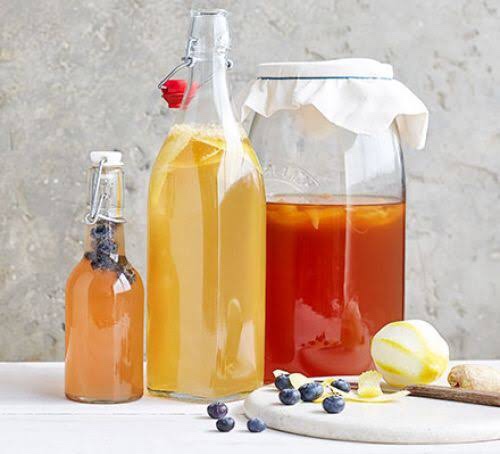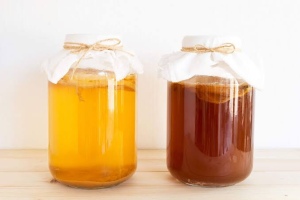Ever wondered how kombucha – the deliciously fizzy fermented tea – is made? We’re breaking down the basics of how to make kombucha, from start to finish! No fancy equipment or ingredients needed.
Kombucha is a fermented tea that has been consumed for thousands of years. Not only does it have the same health benefits as tea — but it’s also rich in beneficial probiotics.
Fermented food has soared in popularity in recent years, in part thanks to the ever-increasing interest and research into gut health. Kombucha, a mildly fizzy, slightly sour drink, has become popular with health-conscious consumers looking for an alternative to processed fizzy drinks that are often packed with sugar or artificial sweeteners.
But is kombucha really good for you, or does it fall short of the media hype? We take a closer look at the potential benefits and side effects of this beverage.
What is kombucha?
Kombucha is a fermented drink made from sweetened tea and a specific culture known as a SCOBY. Scoby stands for ‘symbiotic culture of bacteria and yeasts’. The bacteria and yeasts convert the sugar into ethanol and acetic acid. The acetic acid is what gives kombucha its distinctive sour taste.
Simply put, kombucha is a fermented drink made by adding bacteria and yeast to a mixture of black or green tea and sugar.
The ingredients used to make kombucha may sound sketchy. Yet this drink has become increasingly popular as a potential source of probiotics, which are live organisms that help balance the intestinal flora. “It’s easy to drink and digest, and it allows you to replenish your gut with good bacteria and restore your digestive health ”.
What Are the Benefits of Kombucha?
1. May Help Boost Metabolism
2. May Aid Constipation
3. May Reduce Inflammation
4.May Play a Role in Helping Prevent Cancer
5. May contains antioxidants, can kill harmful bacteria and may help fight several diseases.
How to Make Kombucha
Ingredients for Kombucha
Fresh fruit, juice, or herbs, for flavouring (optional)
HOW TO MAKE A SCOBY
- Bring water to a boil. In a clean, 4-cup wide-mouth glass jar, combine tea and hot water and let steep at least 5 minutes. Using clean utensils, strain out tea or remove the tea bag and stir in sugar, then let cool completely until mixture is room temperature.
- Pour in kombucha, including any sediment in the bottle, and stir to combine. Cover jar with a lint-free cloth, such as a coffee filter. Keep the jar out of direct sunlight in a clean area where it won’t be disturbed, ideally with an ambient temperature between 75° and 80°.
- White snowflake-like clusters, dots, and descending strings of SCOBY will begin to form on the surface and slowly create a film on top, eventually joining together into one cohesive mass with a glossy top. Once SCOBY has formed and grown to at least ¼” in thickness, usually between 1 and 2 weeks but possibly up to 4 weeks, it is ready to be used in your next brew. Reserve tea mixture to use as starter tea in your brew.
HOW TO MAKE A KOMBUCHA
- Bring water to a boil. In a clean, 4-cup wide-mouth glass jar, combine tea and hot water and let steep at least 5 minutes. Strain out tea or remove the teabag, then stir in sugar. Let cool completely, until the mixture is room temperature.
- Begin first fermentation: Pour kombucha into the sweet tea mixture and stir to combine. Using clean hands, add in SCOBY. Cover jar with a lint-free cloth or coffee filter and secure tightly with a rubber band. Keep the jar out of direct sunlight where it won’t be disturbed, ideally with an ambient temperature between 75° and 80°.
- After 3 to 4 days, begin tasting your kombucha. When it reaches the desired amount of acidity, begin second fermentation: Using clean hands, remove SCOBY from the jar and set aside in a clean container. Stir kombucha gently and reserve ½ cup as starter tea for your next brew. Funnel remaining kombucha into a clean brewing bottle, straining if desired.
- To flavour your kombucha, add up to ¼ cup fresh fruit, puree, or juice, or 1 to 2 tablespoonfuls herbs of your choice into the bottle. Secure cap tightly and let the bottle rest out of direct sunlight, “burping” the bottle once a day to release excessive carbonation. When the desired level of carbonation and acidity is achieved, usually in 2 to 3 days, refrigerate kombucha until ready to serve.
Kombucha Recipe Tips :
- Start off with 4-8oz (100-200ml) on an empty stomach in the morning, then with meals to help with digestion or as your body tells you it would like some more! Drink plenty of water as it is a natural detoxifier and you want to flush the newly released toxins out.
- Kombucha in the bottle never “goes bad” as long as no mold is present. However, it may eventually be too sour to enjoy. Refrigeration slows this process.
- To dechlorinate tap water, allow to sit out overnight uncovered or boil for 10 minutes, then cool to needed temp.
- Small variations in tea or sugar used are not a concern. Increase or decrease the amounts to find the Kombucha recipe you prefer, but never use less than ¾ cup (150g) sugar or 3 bags/tsp of tea per gallon.
- Airflow is key, therefore find an open area for your Kombucha drink. A typical empty cupboard or pantry is fine but one jammed with other food items or without any airspace may not work as well.
- Always use cotton cloth covers to allow oxygen to reach the brew. Only cloth with a tight weave should be used. Clean used t-shirts or sheets are a great option. Avoid cheesecloth as the holes are too large and will allow fruit flies and contaminants.
- Soap is not needed when rinsing the brewing vessel between batches unless there was mold or some other brewing issue. If the brew was successful, all that is needed is a clean water rinse.
- Should mold or other brewing issues occur, clean with hot water and soap, then rinse very well with clean water. If the jar has a spigot, remove it and soak in soapy water or bleach to kill any spores, then rinse clean. All items can be cured in distilled (pasteurized) white vinegar. Never use raw vinegar with Kombucha to avoid spoiling the brew.
- To make larger batches, scale the amount of SCOBY and starter liquid with the other ingredients. For a larger Kombucha recipe, one large SCOBY and 1-2 cups starter liquid are recommended per gallon of sweet tea. Batches over 5 gallons in size can experience issues of uneven fermentation.
- Kombucha is a LIVING organism, so many believe the energy in the room will directly influence your culture.
This is a full guide to homemade kombucha tea that costs 30 times less than store-bought. Aha, that’s right!
I hope you like the recipe, share your comments, would love to know your idea of kombucha flavor.





Leave a comment